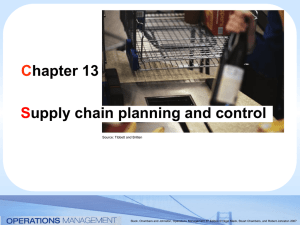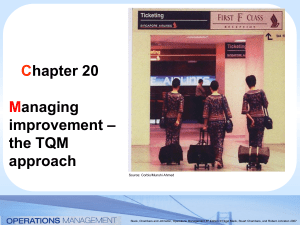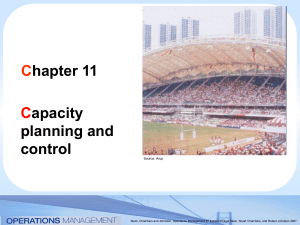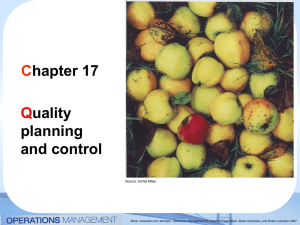PowerPoint Presentations 12
advertisement
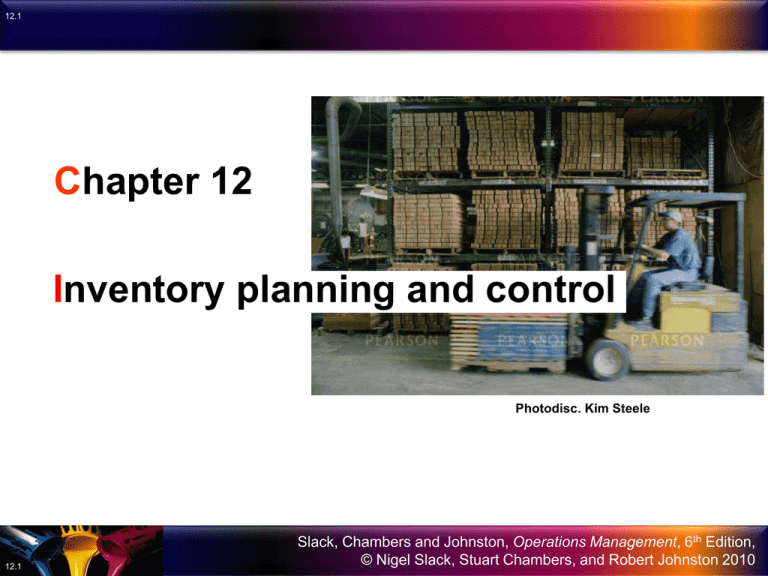
12.1 Chapter 12 Inventory planning and control Photodisc. Kim Steele 12.1 Slack, Chambers and Johnston, Operations Management, 6th Edition, © Nigel Slack, Stuart Chambers, and Robert Johnston 2010 12.2 Inventory planning and control Operations strategy Design Inventory planning and control Improvement Planning and control The market requires… a quantity of products and services at a particular time The operation supplies… the delivery of a quantity of products and services when required 12.2 Slack, Chambers and Johnston, Operations Management, 6th Edition, © Nigel Slack, Stuart Chambers, and Robert Johnston 2010 12.3 Key operations questions In Chapter 12 – Inventory planning and control – Slack et al. identify the following key questions: • What is inventory? • Why is inventory necessary? • What are the disadvantages of holding inventory? • How much inventory should an operation hold? • When should an operation replenish its inventory? • How can inventory be controlled? 12.3 Slack, Chambers and Johnston, Operations Management, 6th Edition, © Nigel Slack, Stuart Chambers, and Robert Johnston 2010 12.4 Inventory is created to compensate for the differences in timing between supply and demand Rate of supply from input process Inventory Rate of demand from output process Input process Output process Inventory 12.4 Slack, Chambers and Johnston, Operations Management, 6th Edition, © Nigel Slack, Stuart Chambers, and Robert Johnston 2010 12.5 Single-stage and two-stage inventory systems Single-stage inventory system Stock Sales operation Suppliers e.g. Local retail store 12.5 Two-stage inventory system Central depot Distribution Local distribution point Sales operation Suppliers e.g. Automotive parts distributor Slack, Chambers and Johnston, Operations Management, 6th Edition, © Nigel Slack, Stuart Chambers, and Robert Johnston 2010 12.6 A multi-stage inventory system Input stock Stage 1 WIP Stage 2 WIP Stage 3 Finished goods stock Suppliers e.g. Television manufacturer 12.6 Slack, Chambers and Johnston, Operations Management, 6th Edition, © Nigel Slack, Stuart Chambers, and Robert Johnston 2010 12.7 A multi-echelon inventory system Garment manufacturers Cloth manufacturers Yarn producers 12.7 Regional warehouses Retail stores Slack, Chambers and Johnston, Operations Management, 6th Edition, © Nigel Slack, Stuart Chambers, and Robert Johnston 2010 12.8 12.8 A paper merchant must get its inventory planning and control right Slack, Chambers and Johnston, Operations Management, 6th Edition, © Nigel Slack, Stuart Chambers, and Robert Johnston 2010 12.9 Inventory profiles chart the variation in inventory level Steady and predictable demand (D) Order quantity = Q Slope = demand rate (D) Inventory level Average inventory =Q 2 Q D Time Instantaneous deliveries at a rate of D per period Q 12.9 Slack, Chambers and Johnston, Operations Management, 6th Edition, © Nigel Slack, Stuart Chambers, and Robert Johnston 2010 12.10 Two alternative inventory plans with different order quantities (Q) Inventory level Demand (D) = 1000 items per year 400 Plan A Q = 400 Average inventory for plan A = 200 Plan B 100 Q = 100 Average inventory for plan B = 50 Time 0.1 yr 12.10 0.4 yr Slack, Chambers and Johnston, Operations Management, 6th Edition, © Nigel Slack, Stuart Chambers, and Robert Johnston 2010 12.11 Traditional view of inventory-related costs 400 350 300 Total costs Costs 250 200 150 Holding costs 100 Order costs 50 Economic order quantity (EOQ) 50 100 150 200 250 300 350 400 Order quantity 12.11 Slack, Chambers and Johnston, Operations Management, 6th Edition, © Nigel Slack, Stuart Chambers, and Robert Johnston 2010 Cycle inventory in a bakery Inventory level 12.12 Produce A Produce B Produce C Produce A Deliver A Deliver B Deliver C Deliver A Produce B Produce C Deliver B Deliver C Time 12.12 Slack, Chambers and Johnston, Operations Management, 6th Edition, © Nigel Slack, Stuart Chambers, and Robert Johnston 2010 12.13 Inventory profile for gradual replacement of inventory Inventory level Order quantity Q Slope = P – D M Q P 12.13 Slope = D Time Slack, Chambers and Johnston, Operations Management, 6th Edition, © Nigel Slack, Stuart Chambers, and Robert Johnston 2010 Inventory planning allowing for shortages Inventory level 12.14 Time Shortages 12.14 Slack, Chambers and Johnston, Operations Management, 6th Edition, © Nigel Slack, Stuart Chambers, and Robert Johnston 2010 12.15 The re-order point Demand (D) = 100 items per week Inventory level 400 Re-order level 300 Re-order point 200 100 0 0 1 2 3 4 Order lead time 12.15 5 6 7 8 Time Slack, Chambers and Johnston, Operations Management, 6th Edition, © Nigel Slack, Stuart Chambers, and Robert Johnston 2010 12.16 Safety stock(s) helps to avoid stock-outs when demand and/or order lead times are uncertain Inventory level Re-order level (ROL) Distribution of lead-time usage Q d1 d2 ? S t2 t1 Time 12.16 Slack, Chambers and Johnston, Operations Management, 6th Edition, © Nigel Slack, Stuart Chambers, and Robert Johnston 2010 12.17 The probability distributions for order lead time and demand rate combine to give the lead-time usage distribution 0.4 Probability Probability 0.4 0.3 0.2 0.1 0 0.3 0.2 0.1 0 1 2 3 4 5 Order lead time 110 120 130 140 Demand rate Probability 0.4 0.3 0.2 0.1 0 100–199 12.17 120–299 300–399 400–499 500–599 Lead-time usage 600–699 700–799 Slack, Chambers and Johnston, Operations Management, 6th Edition, © Nigel Slack, Stuart Chambers, and Robert Johnston 2010 12.18 A periodic review approach to order timing with probabilistic demand and lead time Qm Inventory level Q1 To Q2 T1 T2 t1 tf 12.18 Q3 T3 t2 tf Time t3 tf Slack, Chambers and Johnston, Operations Management, 6th Edition, © Nigel Slack, Stuart Chambers, and Robert Johnston 2010 12.19 Pareto curve for stocked items Percentage of value of items 100 90 80 70 60 50 40 30 Class A items Class B items Class C items 20 10 10 20 30 40 50 60 70 80 90 100 Percentage of types of items 12.19 Slack, Chambers and Johnston, Operations Management, 6th Edition, © Nigel Slack, Stuart Chambers, and Robert Johnston 2010 12.20 Inventory classifications and measures Class A items – the 20% or so of highvalue items which account for around 80% of the total stock value. Class B items – the next 30% or so of medium-value items which account for around 10% of the total stock value. Class C items – the remaining 50% or so of low-value items which account for around the last 10% of the total stock value. 12.20 Slack, Chambers and Johnston, Operations Management, 6th Edition, © Nigel Slack, Stuart Chambers, and Robert Johnston 2010 12.21 If the true costs of stock holding are taken into account, and if the cost of ordering (or changeover) is reduced, the economic order quantity ( EOQ) is much smaller Revised holding costs Costs Revised total costs Original total costs Original holding costs Original order costs Revised order costs Revised EOQ 12.21 Original EOQ Order quantity Slack, Chambers and Johnston, Operations Management, 6th Edition, © Nigel Slack, Stuart Chambers, and Robert Johnston 2010 12.22 The ‘Two bin’ and ‘Three bin’ systems of re-ordering system Two bin system 12.22 Three bin system Bin 1 Bin 2 Bin 1 Bin 2 Bin 3 Items being used Re-order level + safety inventory Items being used Re-order level inventory Safety inventory Slack, Chambers and Johnston, Operations Management, 6th Edition, © Nigel Slack, Stuart Chambers, and Robert Johnston 2010
